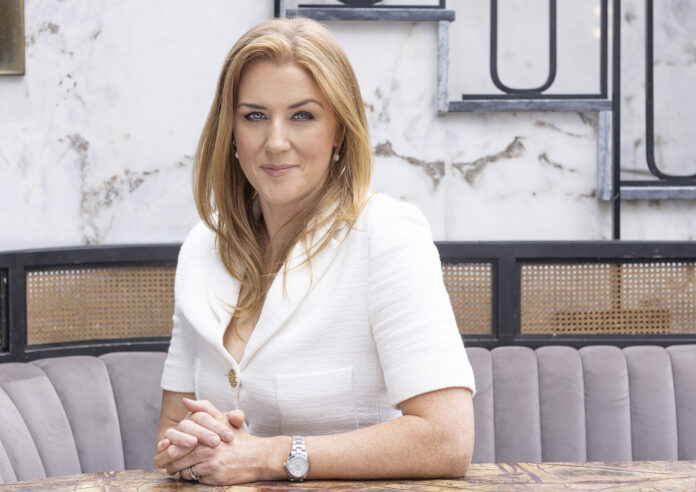
Top Irish skincare expert Eavanna Breen (responsible for the fabulous skin of Irish celebrities such as Greg O’Shea, Thalia Heffernan, Erica Cody and Samantha Mumba) has put together her ultimate guide below on Rosacea: What is it? Why is it such an Irish problem? And most importantly, how do we successfully tackle it?
Rosacea is a bit of an Irish problem. We have one of the highest rates of rosacea sufferers in the world. However, although it is so commonplace, and particularly for the Irish ‘Celtic’ skin type, remarkably we still don’t know exactly what causes the disorder. Some theories suggest it’s down to an autoimmune response to bacteria, while others point to a mite that we all have in our skin called Demodex – it’s been seen to occur in larger numbers on rosacea skin types than others. But there’s still no definite answer.
What we do know for certain are the signs rosacea is coming. And those signs are many and varied.
Renowned Irish skin expert Eavanna Breen says: “Rosacea generally shows itself around the central panel of the face; down the nose and across the cheekbones. And will present with one or more of the following symptoms: flushing, persistent redness, pustules, and papules, telangiectasia (in other words ‘thread veins’), dryness, burning, or stinging. Not pleasant!
“Don’t freak out if you’re displaying red cheeks, as this does not necessarily mean it’s rosacea. It’s important to have any symptoms sufficiently examined by a skin expert like myself, and have them diagnose the issue before considering any treatment.”
As with most skin disorders, people experience rosacea at different levels of severity. Some people might just experience mild flushing and dryness, while others can suffer far more extreme symptoms, with pustules and papules (spots) present. It can look like acne, with the main difference being that blackheads are not present.
Eavanna says: “Some people misdiagnose themselves with acne when it is actually rosacea they have. And months, even years, go by with them attempting to self-fix the problem with acne solutions. So much time is hence wasted treating the problem with the wrong solution, to no results. If they had just come to someone like me from the beginning, so much time and energy could have been saved.”
Although there’s no definitive cure for rosacea right now, there are plenty of ways to treat it and help keep it under control.
NEW INSIGHTS: UNDERSTANDING CAUSES AND EFFECTS OF ROSACEA 2024
Understanding the triggers and effects of rosacea is crucial in its management. Not only is it imperative for maintaining physical comfort, but it also significantly impacts one’s confidence and social life. Rosacea’s visibility can lead to self-consciousness and even avoidance of social situations, affecting overall well-being.
According to recent research, common triggers for rosacea include factors such as diet, lifestyle, stress, temperature changes, and exposure to UV light. Identifying and managing these triggers can play a pivotal role in reducing flare-ups and managing symptoms effectively.
Eavanna emphasizes: “Learning to identify your condition’s individual triggers is key in treating rosacea symptoms. By paying attention to your diet and lifestyle, you can quickly spot what’s causing your flare-ups and start eliminating them.”
Eavanna continues: “Additionally, the psychological impact of rosacea cannot be overstated. Individuals dealing with this condition often experience a decline in self-esteem and confidence due to the visible nature of the disorder. This can lead to social withdrawal and avoidance of activities that may exacerbate symptoms, further affecting their quality of life.”
Eavanna Breen’s top 5 tips to help keep Rosacea at bay now encompass a deeper understanding of its causes and effects:
1. Learning To Identify: Recognise individual triggers and seek professional guidance for effective management. For example Eavanna Breen and her expert team will be able to work with you on both the lead triggers of your rosacea, as well as the best skincare route to treat it.
2. The Usual Suspects: Avoid common triggers such as alcohol, acidic foods, refined sugar, processed meats, dairy, spicy foods, stress, excessive heat, intense exercise, and UV exposure.
3. Effective Sun Protection: Prioritise daily application of high-quality sunscreen to shield against UV damage and reduce flare-ups. Eavanna Breen’s desert Island product is the ‘Skinmade’s Protect & Care Sun Oil’ which she says is by far the best sun protection product she has ever used. Plus its packed full of the world’s strongest antioxidant for added benefits.
4. See A Skin Expert: Consult with a skin specialist to explore tailored treatments such as Laser Genesis, which can help manage symptoms and improve skin condition.
5. The Right Skincare For You: Invest in skincare products tailored to your skin’s needs and seek expert advice for personalised recommendations. It is so important you have an expert to help you find the right home skin care plan that is right for you, and you only. So many people are so often using products that are completely wrong for them.











